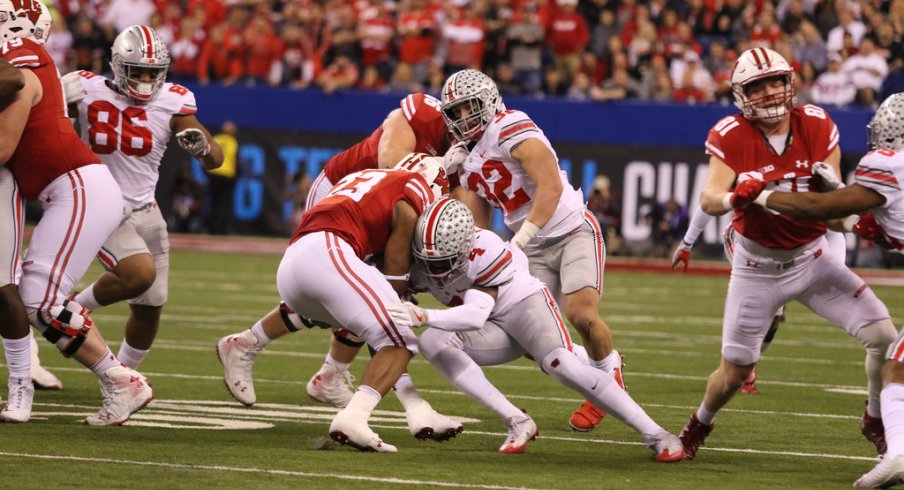Throughout Urban Meyer's six-year tenure in Columbus, the recipe for success on offense has largely looked the same. His team would spread the opposition from sideline-to-sideline before pounding the ball with a physical running game built around the threat of a quarterback run.
On the opposite side of the ball, however, there has rarely been the same kind of consistent schematic trademark. Luke Fickell, Everett Withers, Chris Ash, and Greg Schiano each instilled differing visions during their time working for Meyer, with varying levels of success.
The one constant on the defensive side of the ball under Meyer has been talent, however. While he may spend more of his time on the offensive game plan each week, the head coach has not shied away from recruiting elite talent to that side of the ball.
That focus has not only manifested itself in multiple conference championships and the 2014 national title but in the 22 former Buckeyes defenders that have heard their names called in the NFL draft over that time. Of that group, nine were taken in the first round while only Ezekiel Elliott, Taylor Decker, and Billy Price can say the same for Meyer's beloved offense.
With an expectation that the cupboard will never be short on elite talent, no matter who is in charge, one can't be blamed for not appreciating just how good some of these defensive units have been. Sure, Fickell and Ash were credited with turning Darron Lee from a three-star safety into a first-round linebacker, Schiano has received plenty of praise for turning the cornerbacks room into an NFL assembly line, and line coach Larry Johnson gets his due for the technical prowess with which his pass rushers regularly put on display.
| Year | Avg. YPC Allowed | National Rank |
|---|---|---|
| 2012 | 3.55 | 21st |
| 2013 | 3.29 | 12th |
| 2014 | 3.95 | 43rd |
| 2015 | 3.38 | 14th |
| 2016 | 3.35 | 12th |
| 2017 | 2.94 | 4th |
But while everyone spent much of last fall talking about quarterbacks and pass rushers, the Buckeye defense quietly had one of the nation's top run defenses. This may come as a surprise to many, who bemoaned the state of the linebacking corps or felt that interior linemen like Dre'Mont Jones failed to live up to the 'Rushmen' moniker.
Upon further review, however, the Silver Bullets allowed fewer than three yards-per-carry last season for the first time in Meyer's tenure because of the little things that often go unnoticed. While Schiano and his staff often receive credit or blame for their schematic decisions, the film from 2017 shows that despite what was in the playbook, their focus on the details paid off.
For instance, here is an example of the Buckeyes shutting down a simple zone-read with the best running back in the country last season, Saquon Barkley.

Upon first glance, it appears that the OSU defense employed a simple 'scrape-exchange' between the end being read, Nick Bosa, and linebacker Jerome Baker. This has long been the favored method of stopping such option plays, as the end is taught to crash down on the back no matter what, effectively trading gap responsibilities with the linebacker who will ensure the quarterback never gets outside.
If we look closer, however, it becomes easier to see how Baker was able to get into the backfield and shut down the play so quickly. The aforementioned Jones, who is known most for his ability to get off the snap and make plays in the backfield for himself, does an excellent job of literally holding off the blocker intent on getting to Baker (red arrow below).
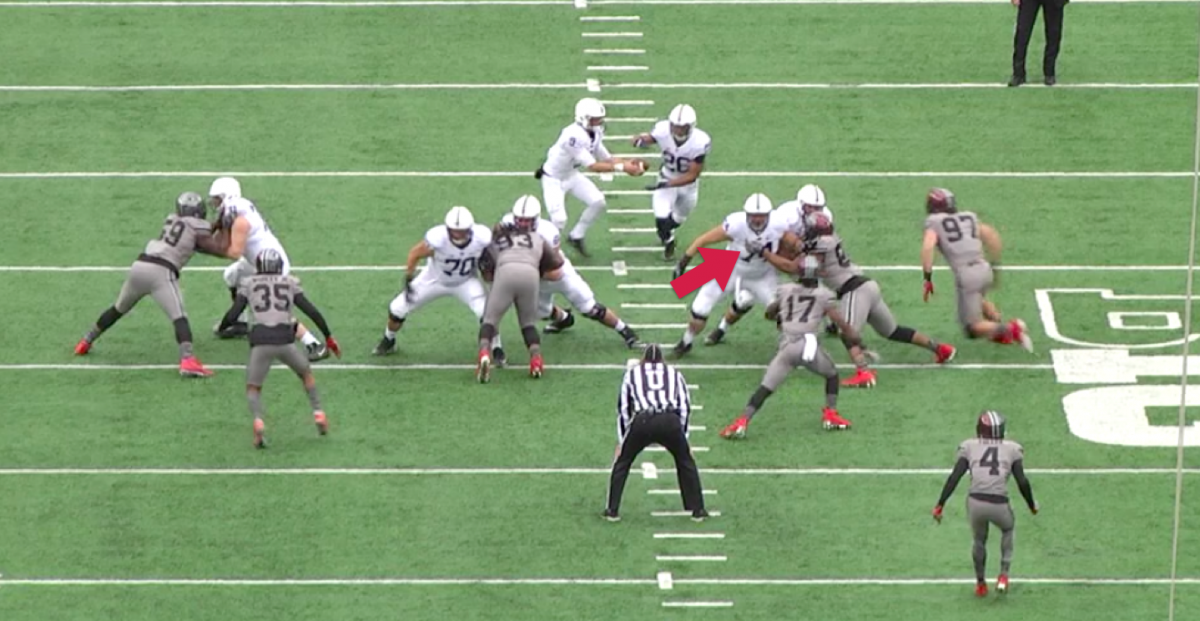
While the elite speed of Bosa forces Trace McSorley to keep instead of handing off and Baker's shuts down any hope of a positive gain, the latter was only able to do so because the projected first-round pick in front of him grabbed the left guard long enough to let the quick linebacker run free.
These types of disruptive efforts can be spotted time and again when reviewing the film of last year's Buckeye defense, even against some of the best rushing attacks in the nation. Below, we see the Big Ten's eastern division champs proving superior to their counterparts from the west in the trenches, as an underappreciated player like nose tackle Tracy Sprinkle makes a tackle-for-loss in the title game.
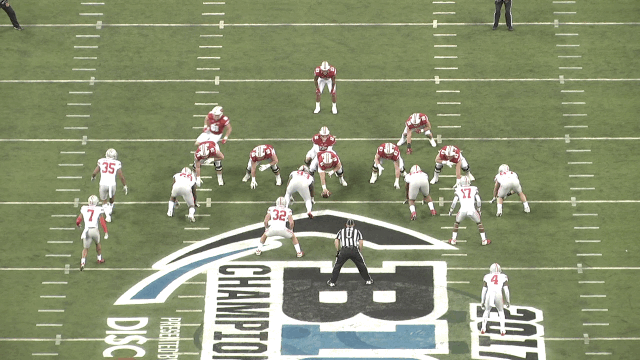
Even here, though, we see Sprinkle making the kinds of winning plays coaches love, and not because he made the tackle. Instead of simply shooting the gap as he slants across the center's face, Sprinkle creates such a violent collision that it knocks the center completely off balance, keeping him from ever laying a hand on his intended target, Tuf Borland.
While it just so happened that Sprinkle was directly in position to wrap up the ball-carrier, the real value he created on the play was freeing up the middle linebacker to mirror the back. Little, overlooked efforts like these piled up throughout the season, most notably against some of the conference's best rushing attacks.
On the first play of the Big Ten title game, the Badgers would get a sense of what was to come all night in Indianapolis, as their counter-trey run was completely stuffed. While the announcers weren't wrong to declare that the Wisconsin offensive line failed to get any movement, it wasn't as if the Buckeyes front line simply won a war of strength and will.

Instead, it was defensive end Jayln Holmes squeezing inside as soon as the left tackle across from him blocked 'down' inside. Holmes' job at that very instant is to follow the 'block down: step down' rule taught to every high school freshman that plays the position, closing any space between he and the blocker and keeping his eyes up for the inevitable block coming his way.
In this instance, it wasn't just one blocker, but two, as the backside guard and fullback pulled across the formation to lead the back through the C-gap in which Holmes was standing. Because Holmes closed the distance so quickly, however, the pulling guard didn't have enough momentum built up to move him upon contact, creating a stalemate that held up the fullback behind him as well, leaving Baker free to shoot through unblocked and make the tackle
These kinds of selfless efforts will never show up in the box score, but are paramount to the concept of 'team defense.' To underscore that point, it's important to point out that these kinds of plays aren't just made by big, defensive linemen either.
Again, looking at the film against Wisconsin we see a Stretch play (outside zone), go for little or no gain as the ball-carrier struggles to find an open gap through which he can cut upfield.

While Sprinkle deserves credit for moving the center backward, and linebacker Chris Worley does a good job reading the play and holding outside contain, the true hero that gums up this entire play weighs all of 183 lbs. As the Badgers line up in this compressed formation, cornerback Kendall Sheffield is forced to follow the receiver inside, close to the big nasties that easily outweigh him by 100 lbs or more.
But upon the snap, the fastest man to ever run a 60-meter dash at Ohio State refuses to give up ground to both the receiver and the tight end sent to move him toward the sideline. Instead, the corner fights through the entire whistle, gumming up the edge of Wisconsin's blocking scheme and actually occupying both blockers the entire time. This tremendous effort allows Worley to come over the top and trade gaps with him, knowing there's no space inside for the back to go.
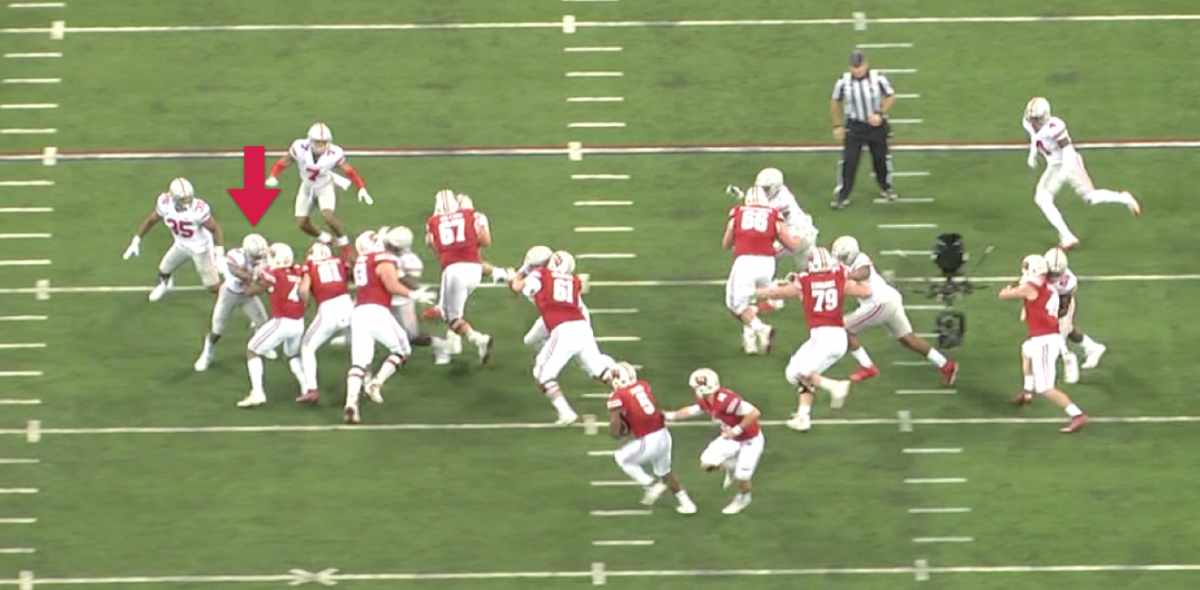
Perhaps the greatest example of the great effort it takes from everyone to play effective team defense against the run came on a 2nd-and-5 in the first quarter against Wisconsin. On a play that would otherwise be lost to history, this simple, two-yard run that ended with a tackle by safety Jordan Fuller shows so much more.

This lead-zone run is simple in its design, as the offensive line looks to create a gap through which the fullback will lead the ball-carrier. While not as common today as it was 15 or 20 years ago, every player on the field that day had seen it countless times before. Sure, there was the additional window dressing of jet motion to lure the defense away from the ball, but other than that, it was a fairly simple call.
Yet when we pause the film just as Jonathan Taylor receives the handoff, so much is revealed. Like a great fresco from the Italian renaissance, this image hides countless details that individually might be meaningless, but come together to tell a much larger story.
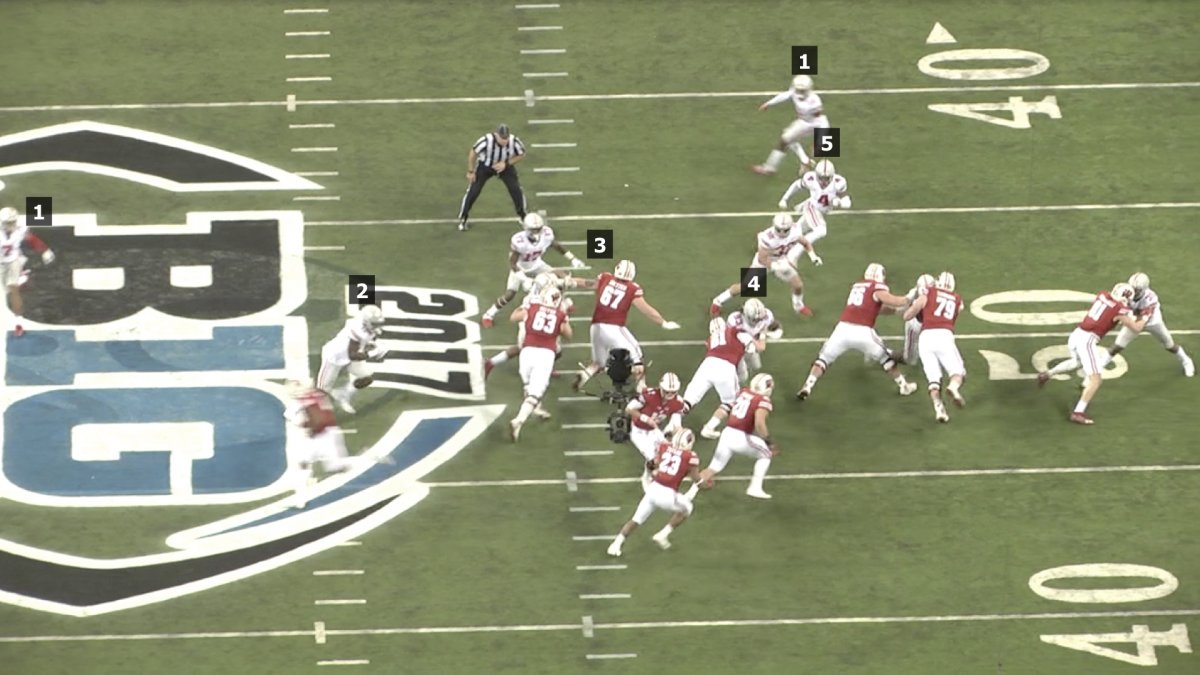
Let's break it down:
- As the receiver went in motion across the formation, cornerback Denzel Ward makes a 'trade' call with the free safety, Damon Webb. Now, Webb is responsible for the receiver no matter what, whether it be to make a tackle had he received the handoff or to blanket him in pass coverage. Meanwhile, Ward assumes Webb's role as the center fielder on the play without disrupting Fuller or any of the other defenders.
- With Webb accounting for the Jet sweep, Holmes pays no attention to the motioned receiver and follows the block down: step down rule again, closing space and eliminating the threat of a cutback from the runner.
- Once again we see Jones using his long arms to disrupt the left guard on his path to the linebacker. Though Jones isn't as successful this time, we see that the effort shown in the first example was a habit, not an anomaly.
- In what became a theme that evening, here's Sprinkle blowing the center backward yet again. This time, though, that effort means the nose tackle can cut off the fullback in the backfield, keeping him from getting close to...
- Jordan Fuller, the 'free hitter' on the play. While the Badgers had this play blocked on paper, with seven blockers for eight box defenders and the Jet motion meant to effectively 'block' Holmes, Fuller should have spent this play absorbing the contact from a 255 lb fullback with a five-yard running start. Instead, thanks to the efforts of his teammates who hold their ground and properly fill their gaps, Fuller is free to fill the C-gap and meet the runner in the hole.
This kind of effort was seen throughout the 2017 season, as the Buckeyes bottled up explosive rushing threats of all kinds, whether it be Army's flexbone, the RPO-heavy attacks of Oklahoma and Penn State, or the pro-style attack of the Badgers.
At the same time, however, it underscores just how disappointing the loss in Iowa City was, as the Buckeye defense played so out-of-character that November afternoon. We may never know how or why, exactly, Schiano's defense laid an egg that day, but what's clear now is that their performance was clearly the exception, rather than the rule.
While that loss may have put the heat on linebackers coach Billy Davis to improve a unit that will have to replace all three starters in the 2018 opener, it should be clear by now that his unit isn't successful on their own. All 11 members of the Silver Bullet defense are required to do the little things that separate a good defense from a great one.
